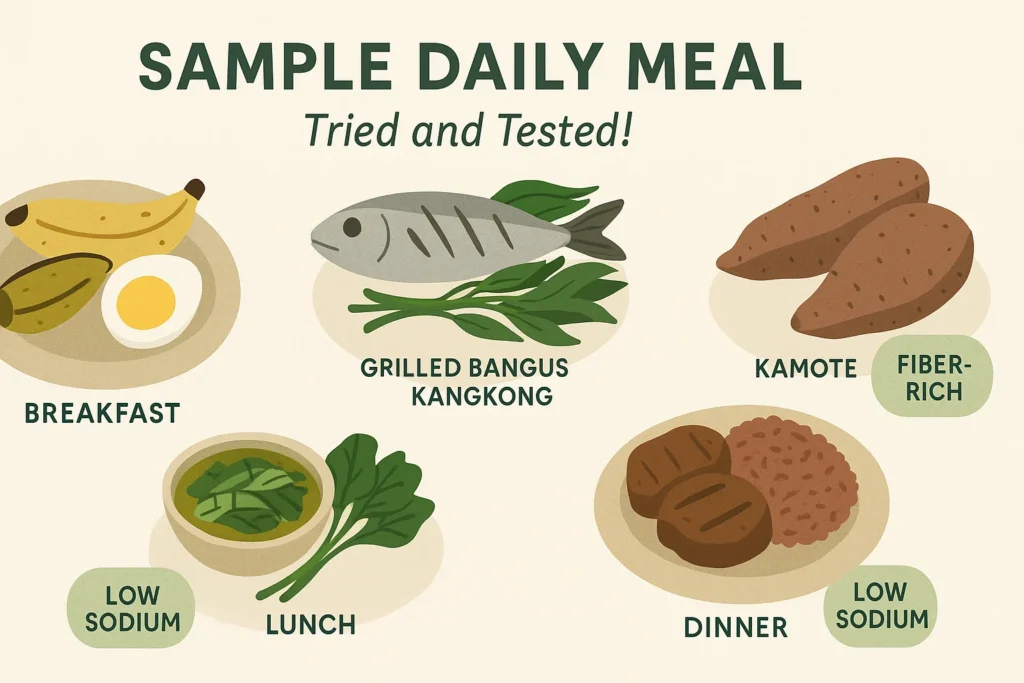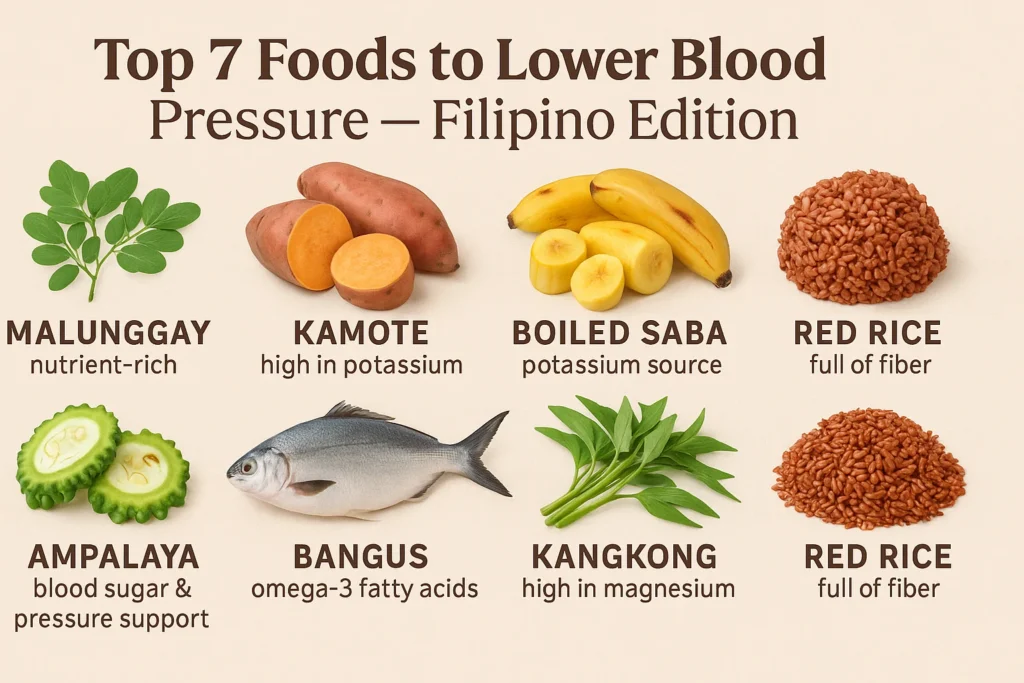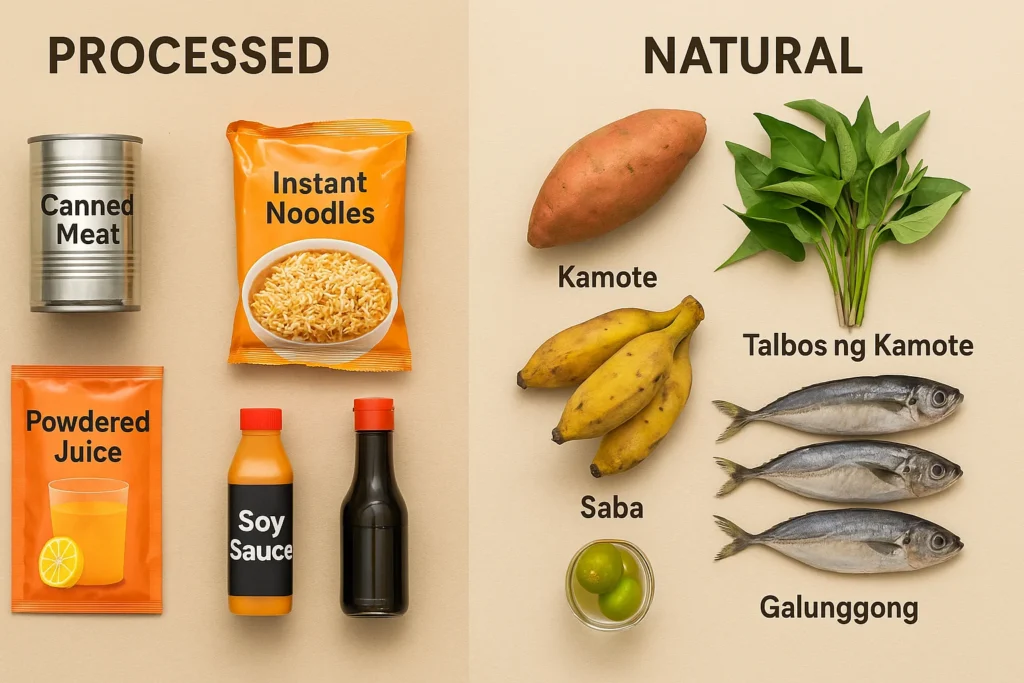Table of Contents
Natural, local, and simple steps to keep your heart healthy—Pinoy style
Foods to lower blood pressure in the Philippines aren’t hard to find — they’re already in your kitchen. And they could be the difference between a healthy life and a silent, dangerous condition. According to the World Health Organization, “Hypertension is the leading cause of early death in the Philippines.”
That hits a lot of Filipinos hard. But it also makes sense.
In our family alone, I can count five people with high blood pressure. My dad, my tito, my lola, and even one of my cousins — and he’s only 23. What’s wild is that most of them didn’t feel sick. They were just tired or feeling out of breath after walking a flight of stairs.
That’s how sneaky hypertension can be. When a client’s blood pressure spiked during a routine check-up, it scared them. They knew they couldn’t rely on medicine alone. Our client had to get serious about natural blood pressure control — and they could do it without giving up the food they love by working with YOU% Nutrition.
A Hypertension Diet Plan in PH That Still Includes Adobo

When people hear about a hypertension diet plan in PH, they imagine bland meals — steamed veggies, no salt, no flavor. But that doesn’t have to be the case.
Our clients still eat adobo. We just switched it up: chicken breast instead of pork belly, less soy sauce, and more vinegar. They still enjoy sinigang, too — with more veggies like labanos and sitaw, and leaner meat.
We realized something important early on: we didn’t need to completely throw away our food culture just to be healthy. We just needed to reframe it. My partner was the first to say it — “Let’s just make smarter choices with what we already love.”
We started with small tweaks. We began by making adobo with leaner cuts. We also learned to balance soy sauce with vinegar, garlic, and peppercorns to keep the flavor strong, but the sodium low. One time, we even added pineapple chunks to chicken adobo. We were skeptical, but wow — that sweet-sour blend hit the spot and felt lighter than the traditional version.
Portion control helped, too. Instead of piling the plate with rice and meat, we shifted the ratio. More gulay, less kanin. And honestly, we didn’t feel deprived. In fact, our clients felt better too — lighter, more energetic, less sluggish after meals.
We also experimented with healthier oils. Instead of frying, we learned to braise or grill meats. For adobo, slow-cooking in a thick-bottomed pot brought out the flavors without needing tons of fat. Sometimes we used canola oil in small amounts, which gave a subtle nutty aroma that made dishes feel indulgent — even if they were low-sodium.
Even the way we served food changed. We moved to smaller plates. Sounds simple, but it worked. Smaller servings looked full, and it encouraged us to eat slower. Less mindless eating, more enjoyment.
Another surprise? One of our client’s mother started helping in the kitchen. It was a way for them to take control of their health. The mother would slice veggies, prepare the garlic, or make sawsawan with calamansi and pepper instead of soy sauce. Having her involved made the meals feel like shared victories.
So yes, a hypertension diet plan in PH can absolutely include adobo. It can include your favorite Filipino meals. The key is to prepare them with care — to know your ingredients, be intentional with your choices, and involve your family.
Because when your health journey doesn’t feel like punishment, it’s easier to stick with. And when the food still brings you joy? That’s when real, lasting change happens.
That mindset made a huge difference for clients working with YOU% Nutrition.
Healthy Pinoy Meals That Help Lower Blood Pressure

Our clients used to think “healthy meals” meant expensive salads or foreign superfoods. But we changed their perception.
What really made a difference for a client’s blood pressure were the healthy Pinoy meals they grew up with — just reimagined. Meals that are simple, natural, and deeply Filipino. That realization saved them a lot of stress and money.
Every food listed here became a regular part of some of our clients’ weekly routine. We sourced most of them from our local markets. Affordable, accessible, and, most importantly, effective. These aren’t trend-driven fads. These are real foods to lower blood pressure in the Philippines that your own family probably eats already.
Let’s dive into what worked.
1. Malunggay
We add malunggay to almost everything — tinola, monggo, even scrambled eggs. This leafy green is a powerhouse. It’s packed with potassium and magnesium, both essential for helping the body regulate blood pressure.
My aunt even dries malunggay leaves and turns them into tea. At first, we all laughed about it, but it surprisingly tasted good — and it helped my uncle who also has high blood pressure. Plus, growing malunggay at home? Super easy. Most families plant one in an old paint bucket outside and it just kept providing.
2. Kamote
Kamote is one of those quiet heroes. High in fiber, naturally sweet, and full of potassium, it supports heart health while also satisfying carb cravings. You can replace white rice with kamote at least twice a week.
Get into the habit of boiling kamote in the morning and storing it for later snacks. So simple. No need to overthink it — just slice and serve. You can even mash it with a bit of cinnamon powder and it will taste like a fancy dessert.
3. Saging na Saba (Boiled)
This was a game-changer when some of our clients were trying to quit sugary merienda snacks. Boiled saba — no sugar added, no frying — became his go-to. It’s naturally sweet and packed with potassium.
They eat one mid-morning and another after lunch if he’s still feeling hungry. It helped control his cravings and stabilized his blood pressure. And the best part? It’s cheap and you can get it almost everywhere.
4. Ampalaya
Bitter, yes. But very worth it.
Our clients, even us at YOU%, were all hesitant the very first time we saw ampalaya as children— not that many in the family loved ampalaya growing up. But we figured out the trick: slice it thin, rinse it, cook it in on low heat for 15-30 minutes, then add in the eggs, onions, and tomatoes. It becomes tolerable. Then kind of good. Then a weekly habit.
Ampalaya supports both blood sugar and blood pressure regulation.
5. Bangus and Galunggong (Grilled)
Marinate them in calamansi and crushed garlic, wrap them in banana leaves or tinfoil, and grill them over charcoal or bake it in an oven. The result? Smoky, flavorful, heart-friendly meals. Both fish are rich in omega-3s and incredibly affordable. Plus, they’re available almost everywhere in the Philippines.
6. Kangkong and Talbos ng Kamote
Dark leafy greens are your heart’s best friend — and they’re some of the best foods to lower blood pressure in the Philippines.
These two — kangkong and talbos ng kamote — are overflowing with magnesium. That mineral helps your blood vessels stay relaxed, supporting natural blood pressure control from the inside out. We toss them into sinigang, sauté them with garlic, or make vinegar-based salads that go great with grilled fish.
And here’s a tip: blanch talbos ng kamote and dip it in calamansi-soy mix. It’s simple but loaded with flavor and nutrients. Even my dad, who wasn’t big on vegetables before, enjoys them now — especially when paired with adobo or grilled bangus.
7. Brown Rice or Red Rice
If we’re being honest, this is the hardest change for most of our clients. Our clients were glued to white rice.
We always encourage our clients to start slow — half white, half brown. Then shift to full brown rice over time. It took a few weeks, but now it’s their default. Red rice works too and has a nuttier taste.
Why is this important? Brown and red rice have more fiber, which slows sugar absorption and helps regulate both blood sugar and blood pressure. For anyone serious about natural blood pressure control, this one is a non-negotiable.
These meals didn’t just lower my client’s blood pressure. They also improved how they felt after eating — no more bloated, sleepy afternoons. Just energy. Lightness. A feeling of being in control.
So if you’re building a list of healthy Pinoy meals to help manage hypertension, start here. These dishes are easy to prepare, rich in heart-friendly nutrients, and grounded in what we already know and love as Filipinos. This was the toughest swap for most. Our clients loved their white rice. But they started with a 50/50 mix and slowly made the full switch. These options have more fiber and help stabilize blood sugar and blood pressure.
What We Cut Back On

According to the Department of Health, the average Filipino consumes nearly twice the recommended amount of sodium daily. That’s a lot — and it’s quietly harming millions of hearts across the country.
When clients decide to focus on natural blood pressure control, they have to take a hard look at their pantry. And they see it. Clients don’t realize how much of their regular food was working against them.
We made sure they stop eating these foods slowly, but they had to cut down hard on these culprits:
- Instant noodles – Sure, they are a quick fix for busy nights, but each pack had over 1,000 mg of sodium. Sometimes double. Even the low-fat versions were salt bombs. Clients used to have them two or three times a week. Now? Maybe once every few months.
- Canned meats and processed food – Some of our clients grew up on Spam, corned beef, and luncheon meat. It was comfort food. But when their blood pressure hit 160/100, they had to read the labels — and see that the sodium was off the charts. They now save these for emergencies, not everyday meals.
- Too much soy sauce, bagoong, and patis – These flavor boosters were on the table at every meal. But we made our clients realize that their “extra patis” habit was quietly driving up sodium intake. A client of mine switched to using more garlic, onions, tomatoes, and natural acids like calamansi or vinegar to bring flavor back. They still use soy sauce, but just a splash — not half a cup.
- Fried everything – Lumpia. Tuyo. Chicken. Even eggplant. Clients fry them all. The oil, the breading, the crispy skin — delicious, yes, but not friendly to the heart. We recommend shifting to grilling, air-frying, and pan-searing with minimal oil. Not the same crunch, but the benefits? Massive. Our clients’ cholesterol levels improved after just a month.
But let me be real: it isn’t easy at first.
There were messages from our clients. Cravings. Moments where my they would sneak a pack of pancit canton. Or they would want ice-cold soda on a hot day. That’s normal. We provide sustainable actions that helped them improve their habits and build long-term lifestyles towards better health.
And honestly, the results from our clients motivate us continue to make us, their dietitians, proud. After three months, our client’s blood pressure dropped. His energy came back. He started sleeping better. And their grocery bills went down because they were buying fewer processed items.
So if you’re serious about building a sustainable hypertension diet plan in PH, choose YOU% Nutrition and let us help you build a nutrition plan centered on YOU.
The key is to make those decisions every day, one meal at a time.
Making the Shift Together
What helped most? Our clients worked with us.
We won’t treat you like a stubborn patient. Your lifestyle and diet are manageable, and for us, that’s already enough reason to work through your concerns.
for example: instead of flavoring food with too much salt or bouillon cubes, with our help, our clients rediscovered old-school seasoning: garlic, onions, ginger, vinegar, calamansi. These became the new essentials of their kitchen. That shift played a big role in their success with natural blood pressure control.
Even their snacks got an upgrade. We always encouraged them to try new recipes. Our clients now preps small snack containers every morning. This makes it easier for them to stay away from chips and powdered juice during snack time.
Our clients also talked about their problems openly. We celebrate your small wins — like the day your BP will drop below 140 for the first time in years. That moment will feel better than any feast.
So yes, our clients made changes. But they made them together with YOU% Nutrition. That’s what made this hypertension diet plan in PH sustainable for them. When you feel the support, it doesn’t feel forced. It becomes your new normal — a healthier, happier one.
Sample Daily Meal (Tried and Tested!)
This free simple one day plan is based entirely on healthy Pinoy meals that support natural blood pressure control. Every item here uses ingredients that are proven foods to lower blood pressure in the Philippines — and yes, it’s affordable and realistic for daily life.
Breakfast: Boiled saba + boiled egg + black coffee
This combo is packed with potassium and protein, helping regulate sodium levels and reduce morning blood pressure spikes. Saging na saba is a perfect local fruit for those starting a hypertension diet plan in PH — it’s filling and heart-friendly.
Lunch: Brown rice + grilled bangus + kangkong adobo
Bangus is rich in omega-3s, making it ideal for anyone prioritizing natural blood pressure control. Paired with brown rice and magnesium-rich kangkong, it’s a complete, satisfying meal that helps keep blood pressure stable through the afternoon.
Snack: Kamote slices + water
Kamote is a fiber-rich root crop known across the country as one of the best foods to lower blood pressure in the Philippines. It’s sweet, simple, and supports steady energy without sugar spikes. Hydration is just as crucial, so we pair it with water — no sugary drinks.
Dinner: Chicken adobo (lean) + talbos ng kamote + red rice
This dinner brings comfort without the cholesterol. Lean chicken adobo still satisfies traditional cravings, while talbos ng kamote (another magnesium-rich veggie) and red rice help relax blood vessels before bedtime. It’s a full-flavored way to end the day while sticking to a practical hypertension diet plan in PH.
The American Heart Association also offers useful tips on eating smart to manage blood pressure. Their science-backed resources align well with our approach to natural blood pressure control.
Don’t Forget the Basics: Water + Movement
Food isn’t the only factor when it comes to natural blood pressure control. Yes, what we eat matters. But how we move and how we hydrate? Just as important.
Every day, 30 minutes of light activities. Sometimes in the morning. Sometimes after dinner. That’s all it takes. Those habits paired beautifully with our hypertension diet plan in PH — like two sides of the same coin.
So yes, if you want real results from your healthy Pinoy meals and lifestyle changes, don’t forget to hydrate. Don’t skip movement. They’re not add-ons — they’re essentials.
Together with better food, these helped our client’s numbers down and gave him back his energy — one glass of water and one walk at a time.
For extra guidance or personalized support, consider consulting a dietitian in Cebu or exploring nutrition services in the Philippines. These resources can help you take the next step with confidence.
Final Thoughts on Natural Blood Pressure Control
Going the natural blood pressure control route isn’t just possible — it’s sustainable.
You don’t need imported superfoods or a pricey diet plan. Just local, honest food and small changes that add up. The best foods to lower blood pressure in the Philippines are already part of our culture.
If you or someone in your family is facing hypertension, try one change. Start small. Make that change with YOU% Nutrition.
One step at a time. That’s how you build a lifestyle that still feels like home.
Want help getting started? We can help you make a hypertension diet plan in PH or a local shopping list. Just book your free consultation with us!



